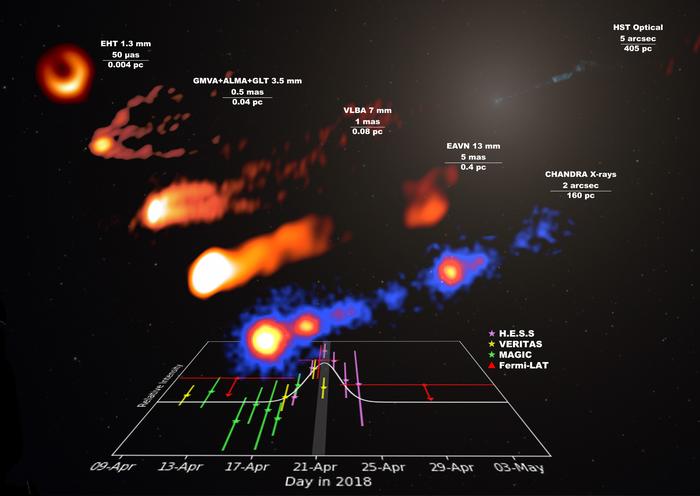Scientists have captured an extraordinary burst of high-energy radiation from the famous M87 black hole, offering unprecedented insights into one of the universe’s most powerful cosmic engines. This rare event, combined with observations across the entire electromagnetic spectrum, is helping astronomers unlock the secrets of how black holes power their enormous jets.
Published in Astronomy and Astrophysics | Estimated reading time: 5 minutes
M87, the brightest galaxy in the Virgo cluster and home to the first-ever photographed black hole, has surprised scientists with an unexpected display of power. During a massive coordinated observation campaign involving over 25 ground-based and orbital telescopes, researchers detected a remarkable gamma-ray flare from its central black hole—the first such event observed in more than ten years.
“The activity of this supermassive black hole is highly unpredictable – It is hard to forecast when a flare will occur,” explains Kazuhiro Hada from Nagoya City University, who led the radio observations. The data collected in 2017 and 2018 reveal contrasting states of the black hole, from quiet to highly active, providing crucial insights into its behavior patterns.
The scale of this cosmic phenomenon is staggering. The relativistic jet examined by researchers extends to sizes tens of millions of times larger than the black hole’s event horizon—a difference comparable to that between a bacterium and the largest known blue whale. The energetic flare itself lasted approximately three days and originated from a region less than three light-days across, roughly 170 times the distance between the Sun and Earth.
Daniel Mazin from the University of Tokyo’s Institute for Cosmic Ray Research notes the flare’s unique characteristics: “The duration of a flare roughly corresponds to the size of the emission region. The rapid variability in gamma rays indicates that the flare region is extremely small, only approximately ten times the size of the central black hole. Interestingly, the sharp variability observed in gamma rays was not detected in other wavelengths.”
Professor Sera Markoff from the University of Amsterdam emphasizes the significance of these observations: “How and where particles are accelerated in supermassive black hole jets is a longstanding mystery. For the first time, we can combine direct imaging of the near event horizon regions during gamma-ray flares from particle acceleration events and test theories about the flare origins.”
Glossary
- Gamma-ray: The highest-energy form of electromagnetic radiation, with energies billions of times greater than visible light.
- Event horizon: The boundary around a black hole beyond which nothing, not even light, can escape.
- Relativistic jet: A powerful stream of particles and energy ejected from the vicinity of a black hole at speeds approaching that of light.
Test Your Knowledge
How long had it been since M87’s last gamma-ray flare?
This was the first gamma-ray flaring event observed from M87 in over a decade.
How many telescopes participated in the 2018 observation campaign?
Over 25 terrestrial and orbital telescopes were involved in the campaign.
What is the approximate size of the flare region compared to the central black hole?
The flare region is approximately ten times the size of the central black hole, as indicated by the rapid gamma-ray variability.
How does the size of M87’s relativistic jet compare to its black hole’s event horizon?
The jet reaches sizes that exceed the black hole’s event horizon by tens of millions of times (7 orders of magnitude), comparable to the difference between a bacterium and the largest known blue whale.
Enjoy this story? Subscribe to our newsletter at scienceblog.substack.com.
If our reporting has informed or inspired you, please consider making a donation. Every contribution, no matter the size, empowers us to continue delivering accurate, engaging, and trustworthy science and medical news. Independent journalism requires time, effort, and resources—your support ensures we can keep uncovering the stories that matter most to you.
Join us in making knowledge accessible and impactful. Thank you for standing with us!

